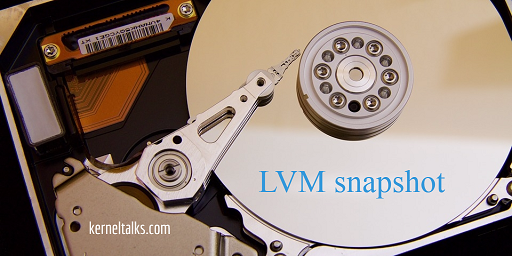Understand what is LVM snapshot and why to use it. Learn how to create, mount, unmount, and delete the LVM snapshot.

LVM (Logical Volume Manager) is one of the widely used volume managers on Unix and Linux. There were series of LVM articles we published at kerneltalks in the past. You can refer them in below list :
- LVM legends
- LVM tutorial on physical volume part I and part II
- LVM tutorial on volume group part I, part II, part III & part IV
- LVM tutorial on logical volume part I, part II & part III
- Difference between LVM and LVM2
- LVM cheat sheet
In this article we will be discussing how to take snapshots of the logical volume. Since LVM is widely used, you must know how to take a backup of logical volume on the LVM level. Continue reading this article to know more about LVM snapshots.
What is LVM snapshot?
LVM snapshot is a frozen image of the logical volume. It is an exact copy of LVM volume which has all the data of volume at the time of its creation. LVM copies blocks or chinks from volume to volume so it’s comparatively fast than file-based backup. Backup volume is read-only in LVM and read-write in LVM2 by default.
Why to use LVM snapshot?
LVM snapshots are a quick and fast way to create a data copy. If your volume size is big and you can not tolerate performance issues while doing online data backup or downtime while doing offline data backup then LVM snapshot is the way to go. You can create snapshots and then use your system normally. While the system is serving production, you can take a backup of your backup volume at your leisure without hampering system operations.
Another benefit of using snapshot is your data remain un-changed while the backup is going on. If you take a backup of production/live volume then data on volume may change resulting inconsistency in the backup. But in case of snapshot since no app/user using it or writing data on it, taking backup from a snapshot is consistent and smooth.
How to take LVM snapshot?
LVM snapshots are easy to take. You need to use the same lvcreate command with -s switch (denotes snapshot) and supply the name of the volume to back up in the end. Important things here are to decide the size of the backup volume. If backup volume size is unable to hold data volume then your snapshot becomes unusable and it will be dropped. So make sure you have little extra space in backup volume than your original data volume (per man page 15-20% might be enough).
Lets create LVM snapshot.
# df -h /mydata
Filesystem Size Used Avail Use% Mounted on
/dev/mapper/vg01-lvol0 93M 1.6M 87M 2% /mydata
# lvcreate -L 150 -s -n backup /dev/vg01/lvol0
Rounding up size to full physical extent 152.00 MiB
Reducing COW size 152.00 MiB down to maximum usable size 104.00 MiB.
Logical volume "backup" created.
In the above example, we created a snapshot of 100MB logical volume. For snapshot we defined 150MB space to be on the safer side. But command itself reduced it to 104MB optimum value to save on space. We also named this volume as a backup with -n switch.
Once the snapshot is created it can be mounted as any other logical volume. Once mounted it can be used as a normal mount point. Remember, LVM snapshots are read-only and LVM2 snapshots are read-write by default.
# mount /dev/vg01/backup /mybackup
# df -h
Filesystem Size Used Avail Use% Mounted on
/dev/mapper/vg01-lvol0 93M 1.6M 87M 2% /mydata
/dev/mapper/vg01-backup 93M 1.6M 87M 2% /mybackup
You can see after mounting backup volume its the exact same copy of the original volume. Original volume mounted on /mydata and backup volume mounted on /mybackup.
Now, you can take a backup of the mounted backup volume leaving original volume un-touched and without impacting its service to the environment.
How to delete LVM snapshot?
LVM snapshot deletion can be done as you delete the logical volume. After backup you may want to delete snapshot then you just need to unmount it and use lvremove command.
# umount /mybackup
# lvremove /dev/vg01/backup
Do you really want to remove active logical volume backup? [y/n]: y
Logical volume "backup" successfully removed
Conclusion
LVM snapshots are special volumes that hold an exact copy of your data volume. It helps in reducing the overhead of read-write on data volume when taking backup. It also helps for consistent backup since no app/user altering data on snapshot volume.